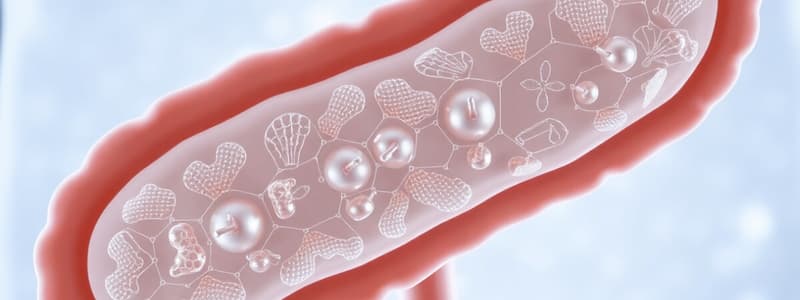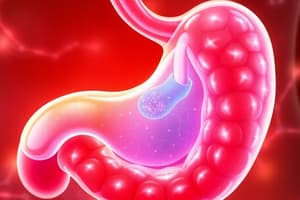Podcast
Questions and Answers
What is the primary role of insulin in glucose metabolism?
What is the primary role of insulin in glucose metabolism?
- To promote the breakdown of glycogen into glucose.
- To inhibit the uptake of glucose by liver cells.
- To facilitate the movement of glucose into cells, thus lowering blood glucose levels. (correct)
- To stimulate the synthesis of glucose from non-carbohydrate sources.
How do insulin and glucagon work together to maintain glucose homeostasis?
How do insulin and glucagon work together to maintain glucose homeostasis?
- They synergistically increase glycogen synthesis in the liver.
- They act antagonistically; insulin lowers blood glucose, while glucagon raises it. (correct)
- They both stimulate the breakdown of fats for energy.
- They both promote the uptake of glucose by cells.
What is the primary factor that triggers the secretion of glucagon?
What is the primary factor that triggers the secretion of glucagon?
- The presence of insulin acting on alpha cells.
- A decrease in blood glucose levels. (correct)
- Increased levels of fatty acids in the blood.
- Elevated levels of amino acids in the blood.
Which cells in the islets of Langerhans are responsible for secreting insulin?
Which cells in the islets of Langerhans are responsible for secreting insulin?
Where does the metabolism of insulin primarily occur?
Where does the metabolism of insulin primarily occur?
What is the expected outcome of insulin binding to its receptor on liver cells?
What is the expected outcome of insulin binding to its receptor on liver cells?
What is the role of insulin in adipocytes?
What is the role of insulin in adipocytes?
What is the effect of glucagon on glycogen stores in the liver?
What is the effect of glucagon on glycogen stores in the liver?
How does the body respond in a fed state, when insulin dominates?
How does the body respond in a fed state, when insulin dominates?
In type 1 diabetes, what is the primary cause of the disease?
In type 1 diabetes, what is the primary cause of the disease?
What is a common symptom of diabetes mellitus related to glucose levels in the urine?
What is a common symptom of diabetes mellitus related to glucose levels in the urine?
What is Biphasic secretion of insulin?
What is Biphasic secretion of insulin?
What is the typical half-life of glucagon in the circulation?
What is the typical half-life of glucagon in the circulation?
In a fasted state, where glucagon predominates, what process does the liver primarily undertake?
In a fasted state, where glucagon predominates, what process does the liver primarily undertake?
Which hormone is considered anabolic?
Which hormone is considered anabolic?
What is the typical half life of insulin?
What is the typical half life of insulin?
Which of the following is released in response to rising blood glucose levels?
Which of the following is released in response to rising blood glucose levels?
Which cells secrete glucagon?
Which cells secrete glucagon?
Which of the following is a catabolic hormone?
Which of the following is a catabolic hormone?
Which of the following is a symptom of diabetes mellitus?
Which of the following is a symptom of diabetes mellitus?
Flashcards
Endocrine Pancreas Function
Endocrine Pancreas Function
The endocrine pancreas secretes hormones like insulin and glucagon to regulate blood glucose.
Glucose
Glucose
Primary substrate for ATP production and regulated by insulin and glucagon.
Insulin
Insulin
A hormone secreted by pancreatic cells that lowers blood glucose levels by enabling glucose to move into cells.
Glucagon
Glucagon
Signup and view all the flashcards
Glucose Regulation
Glucose Regulation
Signup and view all the flashcards
Alpha (α) Cells
Alpha (α) Cells
Signup and view all the flashcards
Beta (β) Cells
Beta (β) Cells
Signup and view all the flashcards
Glycogenesis
Glycogenesis
Signup and view all the flashcards
Glycogenolysis
Glycogenolysis
Signup and view all the flashcards
Insulin Secretion
Insulin Secretion
Signup and view all the flashcards
Insulin Actions
Insulin Actions
Signup and view all the flashcards
Insulin Metabolism
Insulin Metabolism
Signup and view all the flashcards
Tissues responsive to insulin
Tissues responsive to insulin
Signup and view all the flashcards
Anabolic Hormone
Anabolic Hormone
Signup and view all the flashcards
Glucagon Secretion
Glucagon Secretion
Signup and view all the flashcards
Glucagon Actions
Glucagon Actions
Signup and view all the flashcards
Glucagon Metabolism
Glucagon Metabolism
Signup and view all the flashcards
Catabolic Hormone
Catabolic Hormone
Signup and view all the flashcards
Diabetes Mellitus
Diabetes Mellitus
Signup and view all the flashcards
Diabetes Mellitus Symptoms
Diabetes Mellitus Symptoms
Signup and view all the flashcards
Study Notes
- PH1124 Unit 5 Lecture 6 covers the endocrine pancreas, including its anatomy, the secretion and actions of insulin and glucagon, and the main disorder associated with it, Diabetes Mellitus.
- Learning outcomes include describing the anatomy of the pancreas and understanding the roles of insulin and glucagon in regulating glucose levels.
Homeostatic Control of Metabolism
- Glucose acts as the primary substrate for ATP production.
- Glucose levels are controlled by insulin and glucagon, 2 hormones secreted by endocrine cells of the pancreas.
- Blood glucose levels are regulated by the ratio of insulin to glucagon.
- These hormones are secreted on demand and have short half lives.
- They act antagonistically to maintain plasma glucose concentrations within the normal range of 4-7.8 mmol/l.
Anatomy of the Pancreas
- The cells of the islets of Langerhans constitute the endocrine pancreas.
- α cells secrete glucagon.
- β cells secrete insulin and amylin.
- D cells secrete somatostatin.
Glycogenesis
- Glycogenesis is the process of converting glucose to glycogen for storage, requiring energy.
- Glycogen synthase and branching enzymes are involved in Glycogenesis.
Glycogenolysis
- Glycogenolysis is the breakdown of stored glycogen into glucose.
- Glycogen phosphorylase, debrancher enzyme, and phosphoglucomutase are involved in Glycogenolysis, ultimately producing Glucose-6-Phosphate, which is then converted to glucose by Glucose-6-Phosphatase.
Insulin Secretion
- Insulin is stored in granules in the cytoplasm of β-cells.
- A rise in blood glucose detected by β-cells triggers insulin secretion.
- Insulin secretion is biphasic, involving the immediate release of stored insulin, followed by the subsequent release of newly synthesized insulin.
- Insulin secretion is affected by the incretin effect related to other materials on the GI tract.
Insulin Actions
- Insulin lowers blood glucose levels by helping glucose move into cells via glucose transporters and stimulating biochemical activity in cells.
- Insulin acts on insulin tyrosine kinase receptors.
Metabolism of Insulin
- Insulin is metabolized by the kidneys and liver, each accounting for about 50%.
- Insulin has a half-life of about 5 minutes.
Carbohydrate Intake and Insulin Release
- Digestive enzymes in the gut breakdown Polysaccharides and Disaccharides releasing absorbable Monosaccharides
- When blood glucose increases it stimulates the pancreas to release insulin.
- Insulin promotes glucose uptake in the Liver, Adipose tissue and Muscle
Insulin - Responsive Tissues
- Skeletal muscle (myocytes), liver (hepatocytes), and adipose tissue (adipocytes) are the most responsive tissues to insulin.
- Insulin is an anabolic hormone.
- Insulin promotes glucose storage as proteins in muscle, carbohydrates in the liver, and lipids in adipose tissue.
Anabolic Actions of Insulin
- In the liver, insulin promotes glycogenesis and glycolysis from glucose.
- In skeletal muscle, insulin promotes glucose uptake, glycolysis, and protein synthesis from amino acids.
- In adipose tissue, insulin promotes glucose uptake, glycolysis, and lipogenesis from free fatty acids.
Glucagon Secretion
- Glucagon is stored in granules in the cytoplasm of α-cells.
- A fall in blood glucose detected by α-cells triggers glucagon secretion.
- Insulin inhibits glucagon secretion by acting on α-cells.
Glucagon Actions
- Glucagon raises blood glucose, opposing the actions of insulin.
- Glucagon is a catabolic hormone.
- Glucagon acts on glucagon G-protein-coupled receptors.
Metabolism of Glucagon
- Glucagon is metabolized by the liver (~80%) and kidneys.
- Glucagon has a half-life of about 5-6 minutes.
Catabolic Actions of Glucagon
- In the liver, glucagon promotes glycogenolysis to release glucose, gluconeogenesis from amino acids, and oxidation ultimately producing ketone bodies.
- In adipose tissue, glucagon promotes lipolysis to release free fatty acids.
- These actions are catabolic and similar to the metabolic state in diabetes.
Relationship Between Glucagon and Insulin
- In the fed state, the body absorbs nutrients, insulin dominates, resulting in net anabolism.
- Ingested glucose is used for energy production, and the excess is stored as glycogen or fat.
- Amino acids primarily go to protein synthesis.
- In the fasted state, regulation prevents low plasma glucose concentrations (hypoglycemia).
- Glucagon predominates, and the liver uses glycogen and non-glucose intermediates to synthesize glucose for release into the blood.
Diabetes Mellitus
- Diabetes Mellitus is a disorder that occurs when insulin secretion goes wrong.
- There are two types: 1 and 2.
- Main symptoms include hyperglycaemia (high blood glucose), glucosuria (glucose in the urine), polyuria (frequent urination especially at night), polydypsia (increased thirst), polyphagia (increased hunger), and tiredness.
- Treatments for Type 1 diabetes involve insulin, while Type 2 diabetes involves dietary/lifestyle management, drugs, and sometimes insulin.
Diabetes Mellitus Type 1 and Type 2
- Type 1 diabetes has a rapid onset and typically occurs before age 30, peaking at 5 or 13 years.
- Type 2 diabetes has a slow onset and typically occurs after age 40, peaking after age 60.
- Type 1 diabetes presents with weight loss, high urine output, low insulin secretion, ketosis, and >90% β-cell atrophy.
- Type 2 diabetes presents as normal/obese, with normal urine output, normal/slightly decreased insulin secretion, ketosis only on severe stress, and 30-50% β-cell atrophy.
Summary
- The endocrine pancreas anatomy is essential for understanding its function.
- Insulin lowers blood glucose and exerts anabolic effects.
- Glucagon increases blood glucose and exerts catabolic effects.
- The major disorder of the endocrine pancreas is Diabetes Mellitus.
Studying That Suits You
Use AI to generate personalized quizzes and flashcards to suit your learning preferences.




